Buy aquamarine at Tarboz

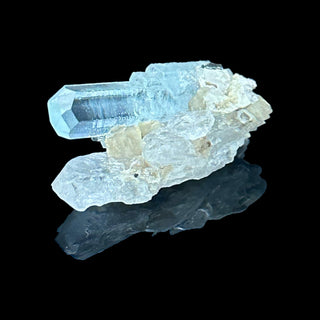

The world of aquamarine
Buy aquamarine at Tarboz
Do you desire gemstones as blue and radiant as the sea? Then an aquamarine from Tarboz is just what you need! The blue of aquamarine radiates harmony and tranquility and has a strong appeal. The crystals are as clear and unfathomable as the depths of the sea, and at Tarboz you will find truly unique pieces , as each raw gemstone is unique.
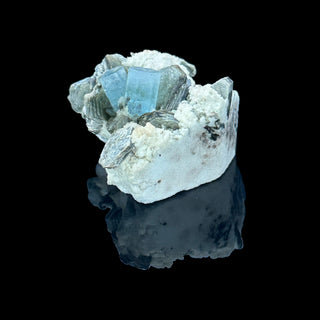

The name Aquamarine
"Aqua marina" or "Aqua mare" means "sea water" in Latin. When you think of the gemstone's beautiful blue-green hue, associations with the color of the sea aren't far off. The name has been known in Europe since the 15th/16th century, although people had been fascinated by the unfathomable blue of aquamarines for centuries before that.
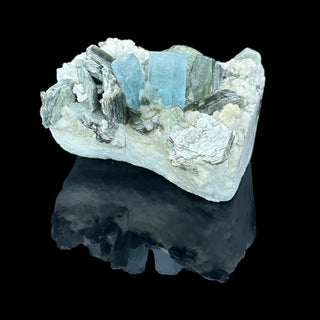

What color are aquamarines?
Aquamarine is the blue variant of the silicate mineral beryl. The blue color is caused by the presence of bivalent and trivalent iron ions. The stone's streak color is actually always white. Therefore, the gemstone, with its distinctive green-blue color, belongs to the to the foreign-colored minerals. Ultimately , aquamarine shines in all the colors of the sea ; from light blue to turquoise to deep blue. At Tarboz, you'll find aquamarine crystals in the most beautiful shades of blue!
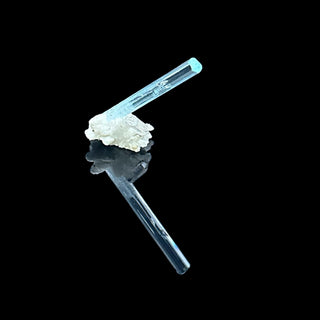

The history of aquamarine
Aquamarine has been known as a special stone for 1,000 years . A portrait of Julia, the daughter of Emperor Titus (39 AD to 81 AD), was even decorated with an aquamarine. The work of art is now on display in the National Library in Paris. Another historically significant aquamarine belonged to Prince Murat, Napoleon's Marshal . He had a beautiful aquamarine incorporated into his sword.
In his work "Naturalis Historia" from 71 to 81 AD, the scholar Pliny the Elder described sapphire-like beryls. Later, between 1240 and 1250, the blue color was listed in the ancient Indian dictionary of Narahari. This demonstrates how far back aquamarine's history goes, which is also one reason for its outstanding importance .
Aquamarine locations
Aquamarine is found primarily in granite, sometimes also in metamorphic rocks. There are 660 known deposits worldwide. Today, aquamarine for commercial use comes primarily from Brazil. Other important deposits are found in Nigeria, Kenya, Mozambique, Madagascar, and Pakistan. At Tarboz, you will find rough gemstones from various countries and learn more about the origin of each individual stone.


Myth of Aquamarine
Mythology says that aquamarine comes from a mermaid’s treasure island and has always stood for
- Purity
- Love and
- Happiness.
The gemstone was once even said to have the ability to distinguish between true and false.
In ancient legends and stories, aquamarine was a lucky stone for sailors. When the weather at sea became stormy, they would throw amulets containing aquamarine into the sea . This special offering was intended to appease the god of the sea, Poseidon.
Aquamarine and esotericism
Aquamarine is said to have several positive properties as a healing stone. Wearing it on a necklace is said to help with respiratory problems, and it is also said to have healing effects on skin allergies, hay fever, and neck pain. It is said to strengthen the eyes of those who spend long periods of time at the computer, and the healing stone is also said to help with stomach or thyroid problems.
We can't medically confirm this, but we're happy to emphasize the positive and harmonious aura of aquamarine. The stone often has a calming effect and makes you more relaxed.
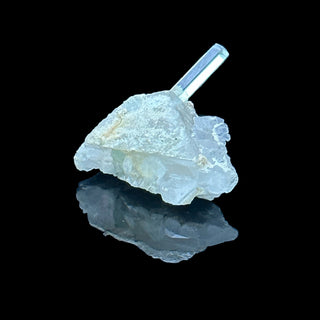

Chemistry of Aquamarine
The stone's Mohs hardness is 7.5 to 8. This degree of hardness, along with the often well-formed, clear crystals, makes aquamarine an ideal gemstone. The physical properties of aquamarine are very similar to those of beryl. It is not uncommon for this colored stone to be brittle and exhibit uneven fracture surfaces. The stone also possesses pleachronic properties, meaning its color depth changes depending on the angle of the light.
The chemical elements of the raw stone aquamarine are
- Beryllium
- Aluminum
- Silicon and
- Oxygen.
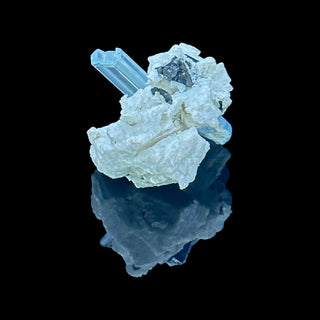

Beware of confusion
A very intense blue is a prize, especially for gemstones. Unfortunately, this color is quite rare in nature. Therefore, lower-quality stones are refined by firing at temperatures of 400 to 450°C. However, it is difficult to distinguish these fired stones from higher-quality aquamarines . This does not have to be disclosed when selling them. However, fired stones are often very sensitive to heat and could lose their color at temperatures of around 100°C or higher. Sunlight or spotlights can also negatively affect the color.
Other imitations made with synthetic quartz, glass, or spinel are available on the market. Furthermore, the stone can easily be confused with blue elbaite, topaz, or zircon. The more intense the blue color, the more expensive the stone. Tarboz will provide you with a certificate from the mine where your aquamarine comes from.
The largest aquamarine in the world
Very large crystals are often found. In 1910, an aquamarine measuring 48 x 38 cm and weighing 110.5 kg, or 530,000 carats, was found in the Marambaia River in Brazil. The largest known aquamarine was not discovered until 1992. At that time, it was one meter long and weighed 400 kg , but was of lesser quality.


Care of aquamarine
Aquamarine is best cared for very gently. Clean it regularly to maintain its special radiance! Usually, simply cleaning the stone with lukewarm, running water is sufficient. Even if you have a real aquamarine at home, be careful not to expose it to excessively high temperatures.
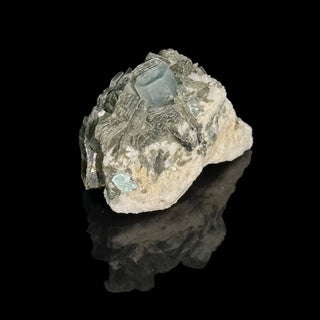

Buy aquamarine
However, turning these high-quality crystals into stunning pieces of jewelry requires careful handling, as the stone is very sensitive to pressure. Step cuts or scissor cuts are often chosen for this blue raw gemstone. If the stone is naturally cloudy, a cabochon cut can still produce fascinating results.
If the gemstone is particularly fine and has a deep blue color, it can boast the quality designation "Santa Maria," named after a mine in Brazil. High-quality "Santa Maria Africana" comes from Mozambique, and "Maxix Aquamarines" come from the mine of the same name in Minas Gerais, Brazil.
They are just as popular as engagement rings as they are as earrings. Some aquamarines make wonderful pearls for particularly exclusive necklaces. Aquamarine jewelry is very luxurious and suitable for almost any piece of jewelry. It is equally popular as a striking eye-catcher on a ring or on a subtle necklace. Incidentally, the stone symbolizes long-lasting love and loyalty. Therefore, an aquamarine ring is a popular gift for a 19th anniversary. Take a look around the Tarboz shop right here and find the most beautiful aquamarine !
